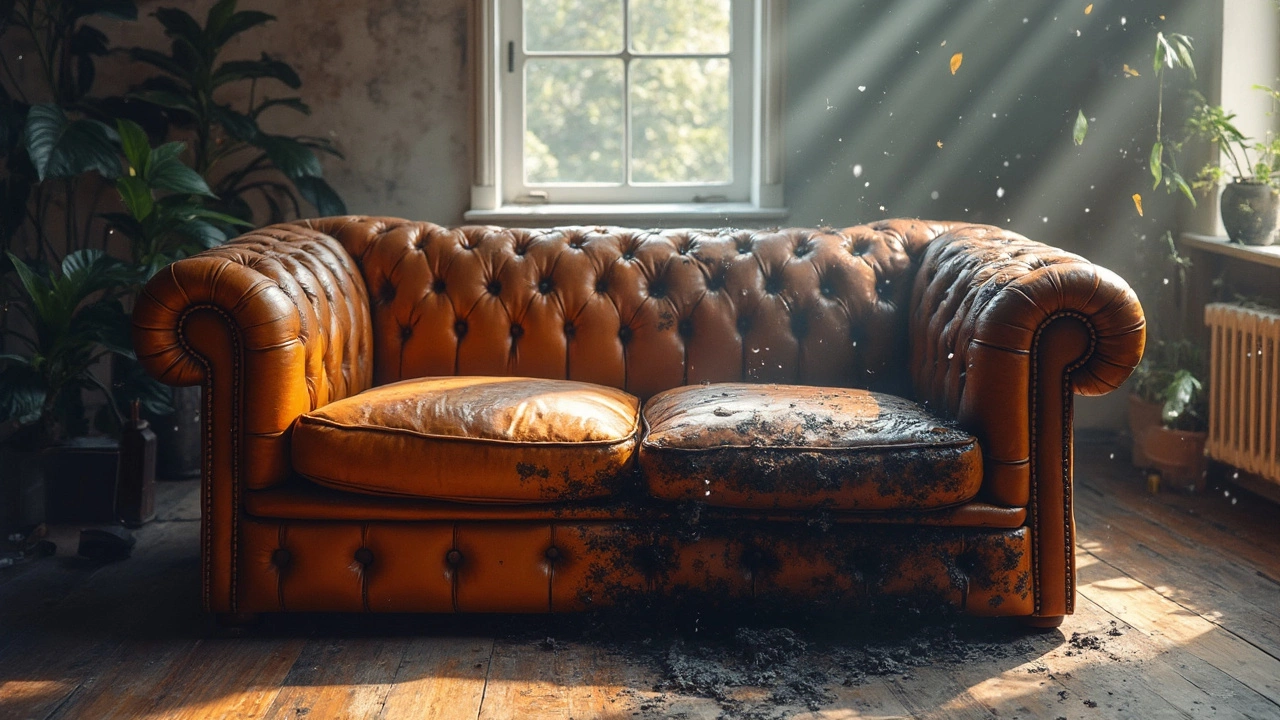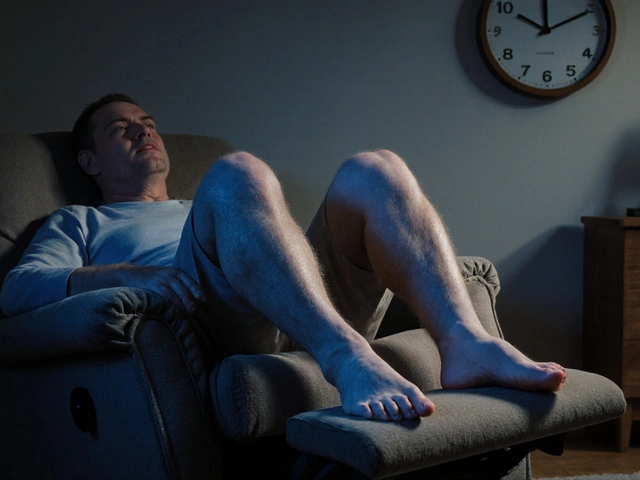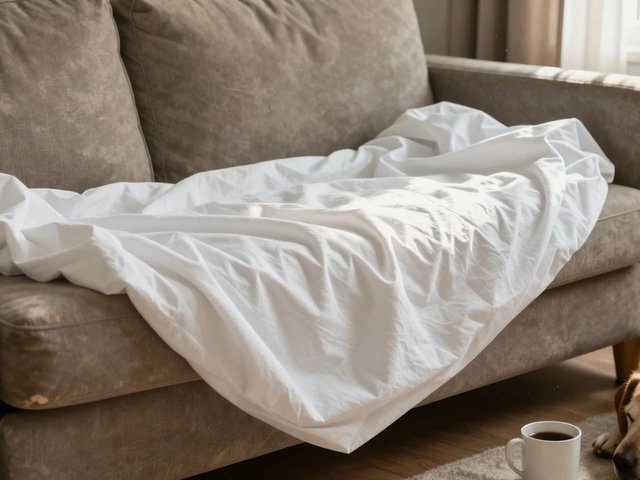Ever pulled your couch out of storage and caught a weird, musty whiff? You’re not alone. Couches can get moldy—sometimes quicker than you think. Mold loves dark, humid spots, which is exactly what a storage unit offers if you’re not careful.
Before you stash your sofa away, you’ve got to think ahead. Mold spores are pretty much everywhere, just waiting for a little moisture to set up shop. Even a tiny bit of dampness in the fabric or cushions is enough to get things growing. Don’t count on plastic wrap to solve everything, either; it can actually trap moisture and make the problem worse if there’s even the tiniest bit inside.
If you want a mold-free couch, the real trick is preventing any moisture from creeping in. And honestly, most people overlook simple things like cleaning spills, drying cushions, or checking humidity in the storage space before storing their furniture. These are the details that make or break the outcome.
- Why Couches Get Moldy in Storage
- Key Signs Your Couch Has Mold
- What Causes Mold Growth on Furniture
- Best Ways to Prepare a Couch for Storage
- Pro Tips to Prevent Mold
- How to Salvage a Moldy Couch
Why Couches Get Moldy in Storage
If you’re wondering whether your couch is safe sitting in storage, here’s the blunt truth: mold shows up way more often than you’d think. It all boils down to three main things—moisture, darkness, and lack of airflow. These conditions are like throwing a welcome party for mold. If you toss your couch in a musty storage unit, especially in humid places, it’s at way higher risk.
Let’s break down what’s actually happening. Mold spores float around in the air everywhere. They land on your couch, and if there’s even a bit of moisture—maybe from summer humidity, a rainy moving day, or leftover sweat—they’ll start to grow. At the same time, most storage places don’t exactly have climate control. That means temperature swings, extra humidity, and air that just sits still—all perfect for mold.
Some eye-opening stats: Furniture stored in units with more than 60% humidity is almost three times more likely to develop mold compared to those kept below 50%. One national self-storage company found that unprotected fabric furniture is one of the top items people call about due to mold problems after just one season in storage.
| Condition | Mold Growth Risk (%) |
|---|---|
| Humidity below 50% | Low (<10%) |
| Humidity around 60% | Moderate (30-40%) |
| Humidity above 70% | High (>75%) |
This is why it matters if you clean spills before putting the couch away. Don’t forget things like hidden crumbs or body sweat, either—those can hold moisture too. Even leather or faux-leather couches aren’t completely safe. Mold can grab onto dust, dirt, and any organic gunk that collects in the corners and seams.
Bottom line, if your couches end up in a place where moisture can sneak in and air can’t move freely, mold is pretty much inevitable sooner or later.
Key Signs Your Couch Has Mold
Spotting mold early can save your couch from getting ruined. Mold doesn’t always look like the big green patches from cartoons. Sometimes it’s faint, hidden, or just looks like a little dirt.
- Strange smells: The most obvious sign is a musty, sour, or earthy odor. If your couch smells weird after coming out of storage, odds are you've got mold.
- Visible spots: Mold can show up as black, green, white, or even grey spots. They might look powdery or slimy. Don’t ignore even small patches—they can spread fast.
- Discoloration: If parts of your couch fabric look a bit off-color or stained, even if it’s subtle, take a closer look. Mold sometimes hides under the surface or in the seams.
- Allergy reactions: Sneezing, coughs, itchy eyes? Mold spores floating around can set off allergies, especially when you sit or move the cushions.
- Soft or damp feel: Mold likes moisture. Run your hand along the couch; if it feels damp or a bit soft and spongy, that’s a warning sign.
If you’re unsure, check any wooden or metal parts, like legs and frames. Mold doesn’t just stick to fabric; it’ll grow on just about anything if there’s enough moisture.
Here’s a quick cheat sheet of what to look (and sniff) for:
| Sign | What to Check |
|---|---|
| Musty odor | All over surface, especially soft areas and seams |
| Color spots | Pillows, cushions, and underneath the couch |
| Dampness | Run a dry hand along the fabric |
| Allergy response | If you sneeze or itch right away |
Never just brush off a funky smell or odd spot. Jump on these signs early if you want to keep your furniture usable and safe.
What Causes Mold Growth on Furniture
Mold on furniture isn’t just bad luck. It’s about moisture, temperature, and how much air moves around. The main culprit? Moisture. When there’s extra humidity in your storage space—think over 60% humidity—mold grows fast. Stuffing a slightly damp couch into a tight space is like sending an invitation to mold.
Temperature matters too. Mold thrives between 60 and 80 degrees Fahrenheit. Most storage units, especially non-climate-controlled ones, land right in that danger zone. Add in poor ventilation, and now you have a hangout spot for mold spores.
A lot of couches are made with materials mold loves: soft foam, fabric, sometimes even wood. If these stay damp, mold colonies can begin in as little as 24 to 48 hours. Plastic wrapping you thought was clever? It just keeps any trapped moisture locked in with your couch. That’s why people are often surprised when their couches come out looking worse than when they went in.
Mold spores are always floating around and they need only three things to grow: moisture, food (which is basically any organic matter), and darkness. Here’s where furniture fits right in:
- Leftover crumbs in seat cushions or under the sofa act as food for mold.
- Spilled drinks, pet accidents, or just not letting a couch dry fully before storage—any of these can start the cycle.
- Dust that collects on unused furniture is mostly organic and adds more fuel for mold.
Want to avoid trouble? Keep stuff dry, let air move, and keep that humidity as low as you can. That’s the real secret.

Best Ways to Prepare a Couch for Storage
Prepping your couch before storage isn’t just a nice idea—it’s how you keep it safe from nasty surprises like mold and weird smells. Most mold problems come from skipping simple prep moves. Here’s how to do it right, step by step.
- Clean it thoroughly. Dust, crumbs, and spills attract mold. Vacuum out every cushion crack. If you spot stains, use a fabric-safe cleaner. Let everything dry for at least 24 hours before moving on. Moisture is enemy number one.
- Disassemble if possible. Take off removable legs or arms. This makes it easier to wrap and carry, and opens up hidden spots where moisture could linger.
- Use the right cover. Plastic traps moisture, so skip it. Instead, use a breathable fabric cover or moving blanket that helps airflow and keeps dust out.
- Choose a dry spot. Even the cleanest couch will get moldy in a damp unit. Go for climate-controlled storage if you can. Usual indoor humidity in a home sits between 30-50%. Anything wetter is risky for your furniture.
- Get it off the floor. Use wood pallets or blocks to lift your couch. Storage unit floors can sweat, especially in humid weather, and that moisture seeps up.
- Let air move. Don’t cram other stuff tightly against your couch. Leave a few inches on all sides so air can flow. Closed-off corners trap moisture and create perfect mold zones.
Here’s how it all breaks down when you compare the potential risks to each storage prep step:
| Prep Step | Reduces Mold Risk | Keeps Couch Fresh |
|---|---|---|
| Thorough Cleaning | Yes | Yes |
| Fabric Cover | Yes | Mostly |
| Climate-Controlled Storage | Yes | Yes |
| Off the Floor | Yes | Drops Odors |
| Leaving Air Space | Yes | Yes |
Most people skip at least one of these steps, and that’s usually when trouble starts. Sticking to this checklist is an easy way to save yourself from a moldy, ruined couch later on.
Pro Tips to Prevent Mold
If you want to keep your couch safe and dry in storage, you’ve got to do more than hope for the best. Mold loves moisture, and it doesn’t take much for things to go wrong. Here’s how you actually protect your sofa, step by step.
- Clean before you store. Vacuum every surface, pull out the cushions, and wipe down any spills or stains. Mold feeds off dirt and food bits, so you want everything spotless.
- Dry is key. Even if your couch looks dry, give it a day or two to air out before moving it. Any trapped dampness is a mold starter kit.
- Use moisture absorbers. Grab some silica gel packs or those big tub dehumidifiers (like DampRid). Stick them near or under the couch, especially if your storage unit is in a humid area.
- Store your couch off the ground. Use pallets or bricks to lift it a few inches. Concrete floors tend to “sweat” and can transfer moisture, even if you don’t see it.
- Don’t seal it too tight. Plastic covers can trap moisture. Use breathable covers or sheets so air can move around but dust stays out.
- Check on your stuff. If you can, open up the unit every couple of months for a quick check and let things air out. The sooner you spot a problem, the easier it’ll be to fix.
Humidity is your biggest enemy in storage. As a rule, anything above 55% relative humidity means you should use serious moisture control tricks.
| Method | Average Mold Risk Reduction |
|---|---|
| Use of moisture absorbers | Up to 70% |
| Elevating couch | About 40% |
| Breathable covers | Roughly 65% |
Keep an eye on these details, and you’ll avoid that nasty shock when pulling your favorite sofa out of storage months down the line.
How to Salvage a Moldy Couch
Spotting mold on your couch right after pulling it out of storage can feel like a nightmare, but don’t rush to dump it just yet. You might be able to save it with the right steps—though some cases, like deep-set mold in foam, may be too far gone. Here’s what you should do for your best shot at bringing that couch back to life.
- Take it outside: First things first, drag your couch outside if you can. Fresh air will help you avoid spreading mold spores inside your home. Plus, sunlight actually kills some types of mold, so let your couch sit out in the sun for a bit.
- Vacuum everything: Use a vacuum with a HEPA filter to suck up as many loose spores as you can from every side, top and bottom. Don’t use a regular vacuum, or you’ll just blast the spores into the air.
- Scrub hard surfaces: If your couch has wooden or metal parts, scrub them down with a mix of one part white vinegar to one part water. Vinegar is great at tackling mold without harsh chemicals.
- Clean fabric: Mix mild dish soap in warm water and gently dab the mold spots using a sponge. Don’t soak the fabric—just dampen it. For stubborn spots, a little vinegar can help. Let everything dry out completely in the sun.
- Deodorize: Sprinkle baking soda on any musty-smelling cushions and let it sit for a few hours, then vacuum it up.
Check out this quick table to see which cleaning methods work on different couch materials:
| Material | Best Cleaning Solution | Drying Method |
|---|---|---|
| Fabric | Soap + Vinegar | Sunlight/Outdoor Air |
| Leather | Leather Cleaner + Vinegar | Towel Dry, Shade |
| Wood | Vinegar + Water | Air Dry |
If the mold smell or stains don’t go away or you spot black mold (it looks dark green or black and sometimes slimy), you might need to call a professional cleaner. Mold in the couch’s core—like deep in the foam or under the fabric—usually means the couch isn’t safe to keep using since mold spores can affect air quality and health.
Quick tip—always wear gloves and a mask when cleaning mold to keep yourself safe. And for the future, a dry, low-humidity storage spot will make all the difference. Keep the couch clean and dry and you can avoid this mess altogether.





